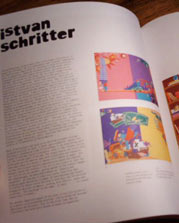Interview by Martin Salisbury (in English)
Interview by Martin Salisbury, in his book Play Pen
The book Play Pen. New Children’s Book Illustration, edited by Laurence King Publishing Ltd. (160 pages, 24 cm x 28 cm) by researcher Martin Salisbury (Head of the Masters Program in Children’s Book Illustration at Anglia Ruskin University, and also author of the highly recommendable book Ilustración de libros infantiles [Children’s Books Illustration] published in Spain by Ed. Acanto) features 35 artists who are “setting trends in children’s book illustration”.

Martin Salisbury: I understand that you are self-taught? Did you not wish to go to art school?
Istvansch: I was always keen on studying and researching on my own; I am extremely orderly and obsessive at it and I believe that I would not had chosen to study at a school, even if I had had the chance. However, the main reason to be self-taught is that, until very recently, there was no possibility to study to become an illustrator anywhere in Argentina. That is why most Argentine illustrators are self-taught.
Only five years ago, the specialization in editorial illustration was opened at Martín Malharro School of Art, located in Mar del Plata (some 300 miles from Buenos Aires) and, because I love teaching, I was in charge of teaching the first Seminar on Children’s Book Illustration at the university level (at the Instituto Universitario Nacional de Arte de Buenos Aires, Postgraduate Programme in Visual Arts Ernesto de la Cárcova). These two spaces, together with a few privately-taught workshops, are the only study options currently available in Argentina, and they have been offered for no more than five years. While the interest in and appreciation for illustration in my country has grown considerably in recent years, you may note that we still lack a specific Degree in Illustration.
It should be clarified that all these advances in terms of recognition were solely due to the efforts by illustrators since, although historically Argentina has had many examples of excellence, it might be surprising to you to see how underestimated and marginal illustration has been –and for some, still is.
(Note: I have written an article on this issue, which was published in France. If you read French, you may find it on http://www.ricochet-jeunes.org/rech.asp?id=74 or www.ricochet-jeunes.org > recherche > les articles critiques > Amerique Latine)
Martin Salisbury: Do you work only with traditional materials or do you also use the computer?
Istvansch:I never use the computer, except for writing or for scanning hard-copies, as a method to record them. While I have illustrated books with more traditional materials, most of them were made with my favourite working material, namely paper clippings. Books as Clear Ideas of Julito in Love, All the Money in the World, Abel Gives Out Suns, Federica is Bored or Des ronds et des carrés (to name but a few) are completely made of paper clippings, even the tiniest of circles, even the tiniest pupil of a small eye is a minute piece of paper. I cut them with a pair of ordinary tailor scissors (and not with dwarf scissors, as many of my readers believe) and with a cutter. I stick the larger pieces with solid glue and the minute ones with liquid glue, with the aide of a pair of tweezers or the leg of a calliper (sometimes pieces of paper are so small that the mere touch of the calliper leg is enough to place them over the glue droplet).
I try not to use ruler and callipers to draw and cut, so that the line that defines the cut is not as perfect as it looks, and this provides warmth to the whole picture.
I enjoy challenging myself to make small and neat cuts beyond imagination. Some of my illustrations add up to twenty or twenty-five different layers of papers, from the landscape layer to the last of details. Even borders and lines are pieces of paper. You will be able to appreciate this in high-quality reproductions, where the shadows that each piece of paper casts over the next are noted.
Martin Salisbury: You have worked on murals. How do you find working to such extremes of scale?
Istvansch: Yes, I have worked at gigantic scales at the Universidad Pedagógica Nacional de México and the Buenos Aires Children Book Fair.
In Mexico, the largest mural is 7m x 5m in size and the smallest is 3m x 1.5m in size. They are made of pieces of fabrics, stuck on fabric and are pliable (they were designed to decorate the huge front yard of the University to celebrate Children’s Day and were later removed and set at the Children’s Library).
In Argentina, I worked with paper and cardboard clippings on hardboard for the booth of the Asociación de Libro Infantil y Juvenil de la Argentina (National Section of IBBY in Argentina). I have also made smaller murals in San Jorge (where I spent my childhood) and in some schools located in inland Argentina.
I felt as comfortable working at gigantic scales as when I work at millimetre scales. The challenge is the same -to create spaces of full detail- and at the same time different from the visual perspective of the illustrator, because the sense of proportion of the drawing is impaired. In Mexico, for example, I worked barefoot on the floor, running over the pieces of fabric to get the whole picture.
Martin Salisbury: You work as Professor teaching post graduate students. Do you enjoy teaching? Does it influence your work? (I also teach post graduate students)
Istvansch: (I would like to describe the situation in Argentina, given that it is quite different from the European situation).
I must say that in the past, nobody paid attention to illustration (and this is no metaphor: nobody did). Argentine children literature reviewers are traditionally educated in Literature and failed to make any comments on the illustrations, except for a few qualitative statements, such as “illustrations follow the text”, or the like, i.e. completely superficial and lacking all specificity.
Ten years ago, the only researchers into this art –by reflecting on our own creative practice and self-learning- were Liliana Menéndez, in the Province of Córdoba, and me, in the City of Buenos Aires.
It is my honour to have opened paths such as the De la Cárcova Seminar, the writing of article for journals in this area, or my book La otra lectura. Las ilustraciones en los libros para niños (Another way of reading. Illustrations in books for children), which is the first theory book edited in Argentina (it was published jointly by Lugar Editorial and the Universidad Nacional del Litoral in November 2005).
Some years ago, reviewers such as Marcela Carranza and Cecilia Bajour (of the Postgraduate Programme in Children Literature, CEPA), started to specialize in picture-books. It is a pleasure to see how new and engaged voices have started to be heard over the last years, such as Mónica Weiss in Buenos Aires, the members of PROPALE and CEDILIJ in Córdoba, and the members of UNL in Santa Fe.
(I will now specifically answer to your question).
Teaching is another of my passions. As I told you before, my students are not postgraduate students as such, but have followed a self-managed path in the area of illustration. In the best of cases, they are graduates of the Degree in Fine Arts or Graphic Design (where –although unbelievable enough- books for children are not even mentioned).
The influence of teaching in my creative work is highly significant. While I was always very actively involved in the creation of my illustrations and in their role in the general structure of the book, teaching has made me more aware of how this internal reading is built within the physical book. Another quite novel event has had an educational influence on me and on many fellow illustrators: since the establishment of the Illustrator Forum/ Argentina, illustrators have become used to sharing our daily activities with our colleagues. We usually share our originals and provide feedback to one another, both to those who have a large number of published books and to students who are rookies in this area. Discovering the look of others is highly educational, especially when this look is so diverse.
Martin Salisbury: Do you have any other thoughts to share on the subject of children's book illustration as a creative field for artists?
Istvansch: : I would like to talk about another event, in which I am also actively involved. I work as editor of a series of picture-books entitled “Libros-álbum del Eclipse” (which you may see at www.deleclipse.com). Never before had an illustrator directed a series of children books in Argentina. And, as in my books my aim is to cause readers take a plunge in them and discover the structure that I created as a body, my approach to this series has been the same. That is why I consider it a creative field, a work that is open to the work of other artists... like a performance in which my role is to co-ordinate the desires of artists and to make them true. The good thing is that this novel idea has been warmly welcomed by reviewers and readers, with several awards in Argentina and internationally.
There were no series of this kind in Argentina; all series followed pre-established format and design guidelines, with illustrations as subsidiary to the text. My aim was to avoid repeating those models and to follow the authors’ wishes regarding all creative aspects. Thus, some of the books are large and others are small; some of them have a lot of pages and others, only but a few; some of them are luxury editions, and others, paperbacks; some are classics and others, first editions; some were created by a writer and an illustrator working side-by-side and others, by a single author. In this series, there is no need for external markers to identify the series, since the factor bringing all titles together is a conceptual axis defined as the full integration between text and images in a complementarity relationship.
Lastly, I would like to thank you for taking the time to look at the artists that live in the farther South, and to tell you about my new books (with text written by me), which I have not had the chance to upload to the website or that are in press: Todo el dinero del mundo (“All the Money in the World” - Buenos Aires, Ed. Sudamericana, Colección “Puercoespín”), Boca de león (“Lion Mouth” - Buenos Aires, E.D.B., Colección “Flecos de sol”), ¿Has visto? (“Have you spotted?” - Buenos Aires and Barcelona, Ed. Del Eclipse, Colección “Pequeños del Eclipse”), Cuento de no creer, La semana del gato valiente, Todo lo que es Juan (“A Tale Not to Believe”, “The Week of the Brave Cat” and “All that Juan Is”- Buenos Aires, Ed. A/Z, “Serie de Istvansch”).
